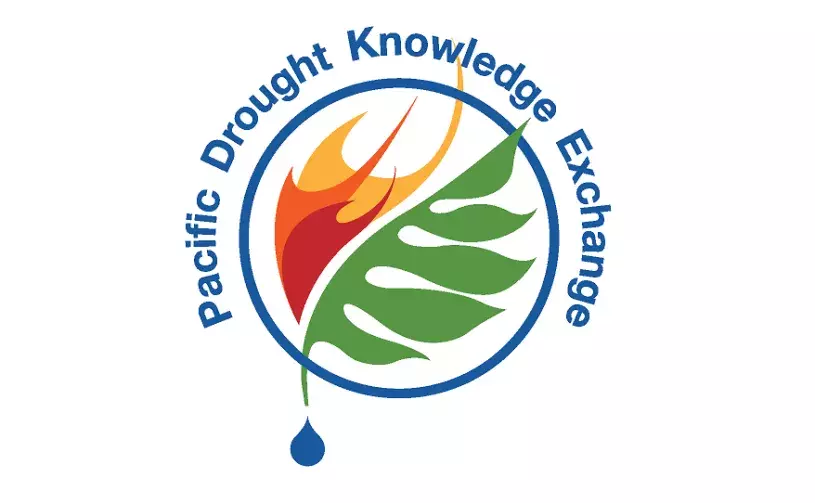
ABOUT
The Pacific Drought Knowledge Exchange (PDKE) seeks to facilitate drought knowledge exchange and enable collaborative relationships among drought stakeholders in Hawai‘i and in Pacific Island Nations. We work to co-produce site-specific, customized drought data and products based on the needs of our manager partners. Through active engagement between researchers and managers, we strive to make drought and climate data products more accessible to managers for drought planning and management.
Climate change, climate variability, and drought (CCVD) will exert a growing impact on landscapes, watersheds, and nearshore areas in the Pacific Islands. Droughts in the Pacific Islands can be extremely severe, causing drinking water shortages, extensive crop damage, and increases in the size, severity and extent of wildfires that burn incredibly large percentages of island land areas. A recent analysis of historical drought in Hawai‘i found that drought duration, magnitude, and frequency have all increased significantly, consistent with trends found in other Pacific Islands. While land managers are tasked with utilizing the “best available science”, they often are confronted with data products that are difficult to access and there is no facilitated communication process with researchers to meet the needs of resource managers.
To address this gap, we established the PDKE to explore knowledge co-production among researchers and resource managers with the goal of expanding the utility of drought-related information for end users. Through information, training, and tools, we aim to support:
- Easier access to information sources
- Better and more comprehensive information
- Improved technical assistance
- A more collaborative information transfer environment
The first two phases of the PDKE have worked with a small number of pilot partners to explore knowledge co-production, assess drought-related management needs, and co-produce site-specific climate and drought products, including factsheets and portfolios using available data (now automated). These phases have successfully demonstrated how this knowledge exchange process can improve drought management and planning in the Pacific.
PRODUCTS
CCVD Portfolios
The climate change, climate variability, and drought (CCVD) portfolios are a comprehensive synthesis of site-specific climate and historical drought information for individual land management areas. These portfolios are co-developed and designed to provide both research scientists and land managers with relevant climate and drought information needed to inform land management decisions and to guide future research and extension. To date the PDKE team has produced over 100 of these portfolios for land and resource managers in Hawaii (see examples below).
- Mauna Kahālāwai Watershed Partnership (Maui)
- Kaho‘olawe
- Moku of Halelea (Kaua‘i)
- Hawaii Volcanoes National Park
Factsheets
The PDKE has worked with stakeholders and research managers to develop factsheets that can be used for educational purposes, staff training, and community outreach.
State Of Hawai‘i
- Drought and Non-Native Mammals in Hawai‘i (ʻŌlelo Hawaiʻi)
- Drought and Conservation Operations in Hawai‘i (ʻŌlelo Hawaiʻi)
- Drought and Ecological Restoration in Hawai‘i (ʻŌlelo Hawaiʻi)
- Economics of Drought in Hawai‘i
Hawai‘i Volcanoes National Park
- Impacts of El Nino at HAVO (ʻŌlelo Hawaiʻi)
- Future Climate Projections at HAVO (ʻŌlelo Hawaiʻi)
- Drought at HAVO (ʻŌlelo Hawaiʻi)
Pu‘u Wa‘awa‘a Experimental Tropical Forest
- Impacts of El Nino at Pu‘u Wa‘awa‘a (ʻŌlelo Hawaiʻi)
- Future Climate Projections at Pu‘u Wa‘awa‘a (ʻŌlelo Hawaiʻi)
- Drought at Pu‘u Wa‘awa‘a (ʻŌlelo Hawaiʻi)
- Fire at Pu‘u Wa‘awa‘a (ʻŌlelo Hawaiʻi)
- Guam
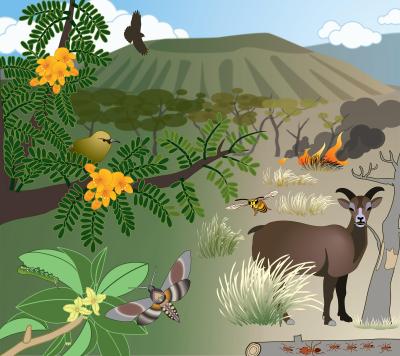
Publications
- Longman, R. J., and Coauthors 2022: The Pacific Drought Knowledge Exchange: A co-production approach to deliver climate resources to user groups, Sustainability (Link)
- Frazier A.G., and Coauthors, 2022: A Century of Drought in Hawai‘i: Geospatial Analysis and Synthesis across Hydrological, Ecological, and Socioeconomic Scales, Sustainability (Link)
- Frazier, A. G., and Coauthors, (In Preparation): Hawaii Drought Needs Assessment. Pacific Cooperative Studies Unit.
- Longman, R. J., and Coauthors, 2021: Climate Adaptation for Tropical Island Land Stewardship: Adapting a Workshop Planning Process to Hawai‘i. Bulletin of the American Meteorological Society. (Link)
- Frazier, A. G., and Coauthors, 2019: Drought in Hawai’i and U.S.-Affiliated Pacific Islands, General Technical Report: Effects of Drought on RangeLands and Forests in the United States. (Link)
Workshops
- December 2, 2022: The PDKE held a kickoff meeting (Agenda) to begin conversations on how to move forward with the project. The main objective of the meeting was to determine how a range of agencies might come together to form an alliance model to support future activities. The meeting began with a few short presentations followed by breakout rooms and group wrap up. Two of the presentations can be found at the links below.
- January to March 2021: The USFSʻs Northern Institute of Applied Climate Science (NIACS), in collaboration with and funded by the SWCH, coordinated with the PDKE to lead an “Adaptation Planning and Practices (APP)'' Training for Hawai‘i-based stewardship professionals. This eight-week course was attended by more than 40 participants, representing Federal and State government agencies, nongovernmental organizations, academia, and private landholders. Participants met remotely to receive practical training in how to use climate change information to identify and design adaptation actions for their natural and cultural resources spanning forests and rangelands across a wide diversity of Hawaiʻiʻs ecosystems.
- April 15-18, 2019: Pacific Islands forestry professionals workshop, East-West Center, Honolulu. Session Title: “Drought and fire: Learning from Pacific fire exchange”. Co-Sponsors: USDA Forest Service, Council of Western State Foresters. Conveners: C. Trauernicht, A.G. Frazier, S. Cordell, M. Kunz, and C.P. Giardina.
- August 14-15, 2018: Drought in the USAPI—impacts, resilience, and management, East-West Center, Honolulu. Co-Sponsors: U.S. Geological Survey National Climate Adaptation Science Center, the Department of the Interior Pacific Islands Climate Adaptation Science Center, and the USDA Institute of Pacific Islands Forestry. Conveners: A.G. Frazier, S. Constanzo, B. Walsh, and B. Meyers.
Website
A talented team of web developers is working to design a streamlined way to access all PDKE products as well as climate and drought information for the State of Hawaii. In Development. http://www.soest.hawaii.edu/pdke/home/
ONGOING PROJECTS
Climate Change, Variability, and Drought in the U.S.-Affiliated Pacific Islands – Working with Managers to Mitigate the Impacts of Drought and Wildfire (2021-2022)
This project aims to inform management responses to the impacts of drought and wildfire across the westernmost jurisdictions of the USAPI: Palau, Guam, and Yap. First, researchers will improve previous efforts to characterize past drought events and wildfires on the islands, resulting in substantial improvements to the mapping of drought and wildfire events. They will then work collaboratively with resource managers in the Guam Department of Agriculture and the Yap Division of Agriculture and Forestry to identify and synthesize actions taken by land managers in response to drought and wildfire in the past in order to establish “lessons learned” and identify needs for future investments. The results of this work will increase the accuracy and accessibility of drought prediction and fire risk warnings in the USAPI and explicitly link these predictions to a suite of operational responses that can increase the capacity of local agencies to reduce the negative impacts of drought across the region.
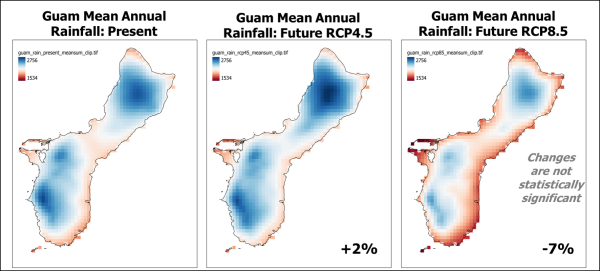
The Hawaii Rangeland Information Portal (2020-2024)
A team of researchers from the EWC and UH are working with the ranching community to better understand how climate characteristics can affect forage production for different grass types. Rainfall-forage relationships for different grass types are not well understood; however, this information (if available) would provide ranchers with critical information necessary for assessing the forage needs of their livestock. To make this information readily available the Hawaiʻi Rangeland Information Portal (H-RIP) is being developed as place to access climate and drought information and decision support tools. The H-RIP tool will have four primary functions: 1) a 1-3 month forecast of forage growth based on an almanac perspective of rainfall during different El Niño phase events; 2) near-real estimates of rainfall and temperature trends; 3) site-specific decision support tools that managers can use to assess site-stability and to manage animal-stocks; 4) Near-real-time climate and information that can be used to assess insurance payouts to ranchers during times of drought, and 5) site-specific information on annual climate, rainfall trends, and historical drought events.
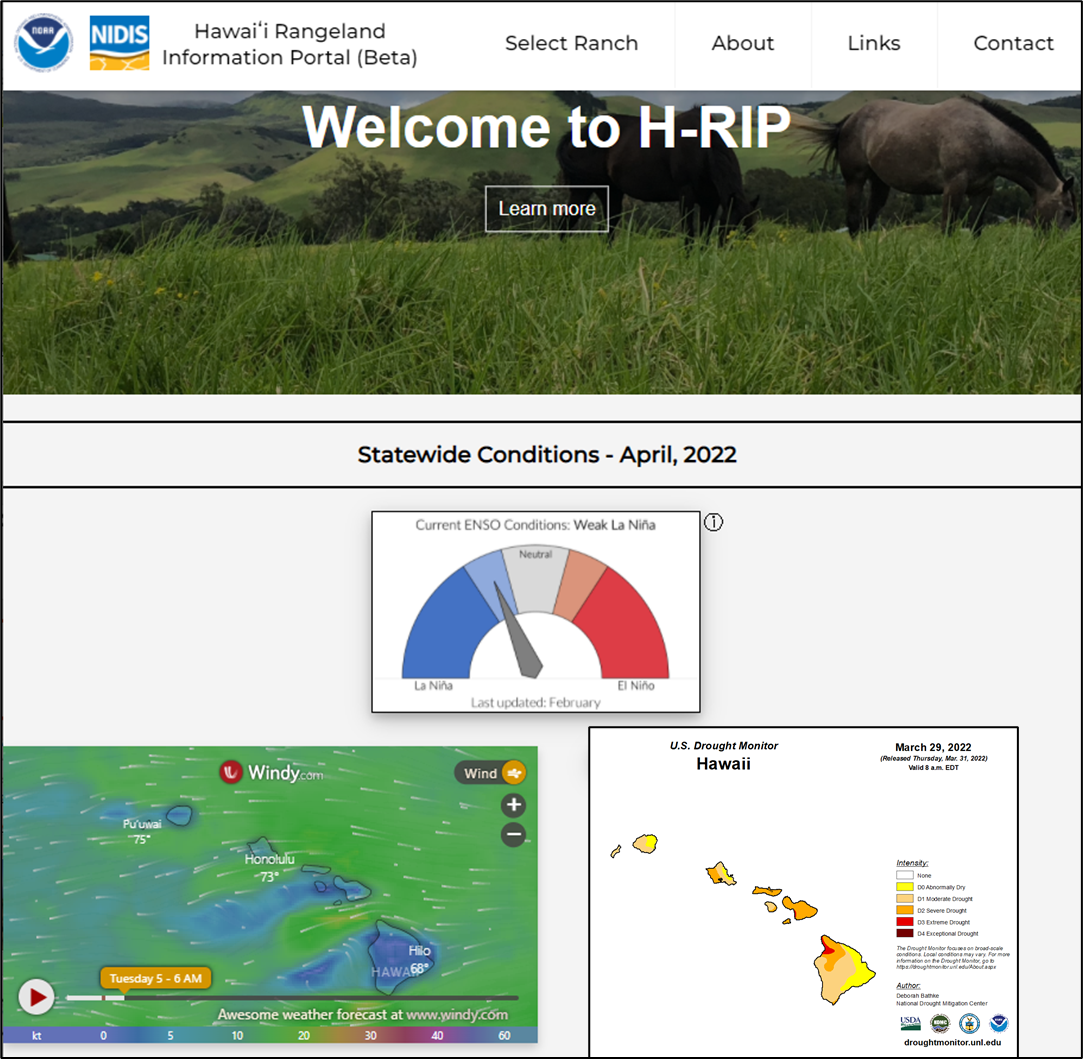
Scaling up PDKE efforts with Stakeholders in Hawaii (2022-2023)
PDKE efforts are currently being scalled up to include 10 new potential partner sites: five new DOI management units (Haleakalā NP has shared a strong interest in participating in the PDKE; potential other sites include Pu`uhonua O Hōnaunau NHP, Pu‘ukoholā Heiau NHS, and Honouliuli National Historic Site); three new state entities (Mauna Kea Watershed Alliance, Three Mountain Alliance, and Wai‘anae Mountains Watershed Partnership have shared a strong interest in participating in the HDKE); and multiple Native Hawaiian land management units (Department of Hawaiian Homelands has shared a strong interest in participating in the HDKE).
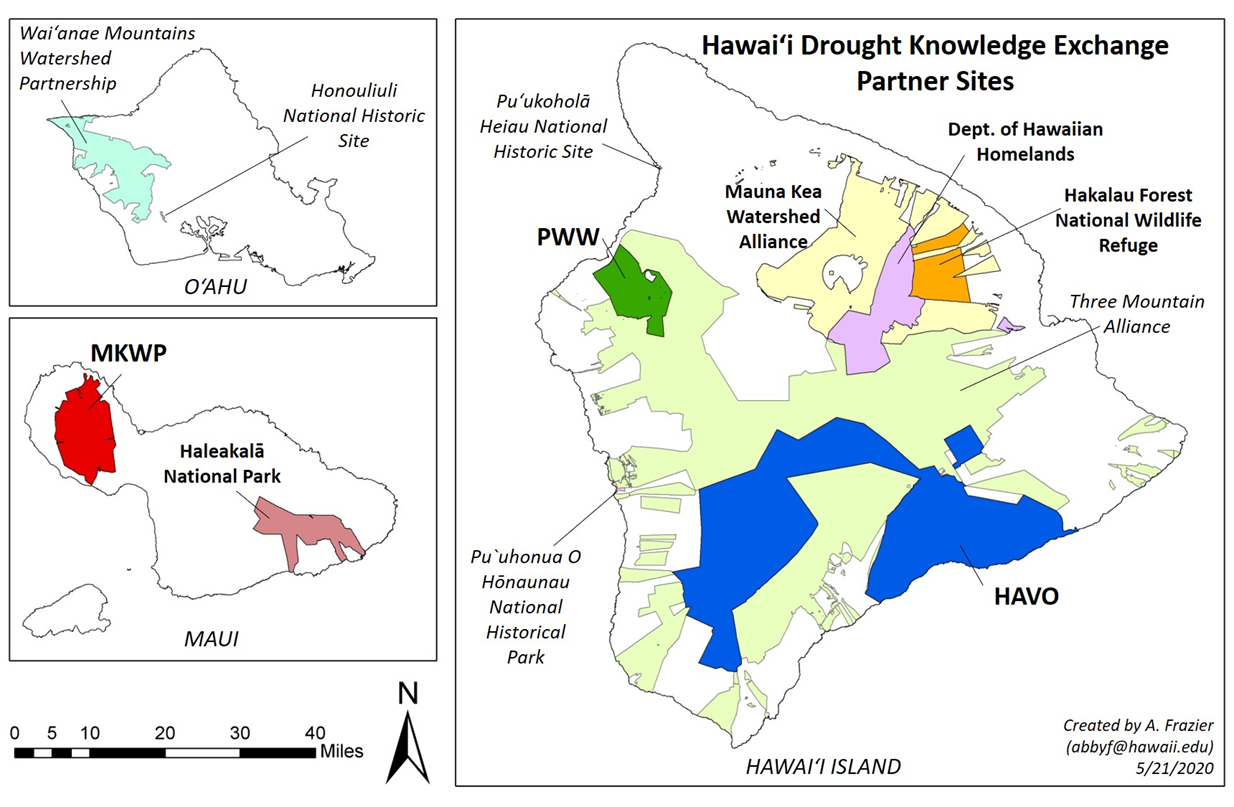
The Hawaiʻi Climate Data Portal (ongoing)
The Hawaii Climate Data Portal. HCDP is an online platform that provides easy access to climate data and information for the State of Hawai‘i. Over the past four years, a team of climate and data scientists have worked collaboratively to design a system that streamlines the acquisition, storage, quality control, and accessibility of climate data in the State. They have also developed methods to produce high resolution near-real-time monthly rainfall and daily temperature maps which are available for both visualization and download through the Portal. The HCDP will eventually provide near-real time information on fire and drought risks and waring across the State. Beginning in the Fall of 2022 a new version of the CCVD portfolios (described above) will be generated to include the most up to date data and information generated through the HCDP platform.

Key Personnel
Ryan Longman, Oceania Research Fellow, East-West Center
Abby Frazier, Assistant Professor, Graduate School of Geography, Clark University
Christian Giardina, Research Ecologist, United States Forest Service
Derek Ford, Project Specialist, East West Center
Alyssa Anderson, Climate Change Extension Specialist, Pacific Islands Climate Adaptation Science Center
ABOUT
The Pacific Drought Knowledge Exchange (PDKE) seeks to facilitate drought knowledge exchange and enable collaborative relationships among drought stakeholders in Hawai‘i and in Pacific Island Nations. We work to co-produce site-specific, customized drought data and products based on the needs of our manager partners. Through active engagement between researchers and managers, we strive to make drought and climate data products more accessible to managers for drought planning and management.
Climate change, climate variability, and drought (CCVD) will exert a growing impact on landscapes, watersheds, and nearshore areas in the Pacific Islands. Droughts in the Pacific Islands can be extremely severe, causing drinking water shortages, extensive crop damage, and increases in the size, severity and extent of wildfires that burn incredibly large percentages of island land areas. A recent analysis of historical drought in Hawai‘i found that drought duration, magnitude, and frequency have all increased significantly, consistent with trends found in other Pacific Islands. While land managers are tasked with utilizing the “best available science”, they often are confronted with data products that are difficult to access and there is no facilitated communication process with researchers to meet the needs of resource managers.
To address this gap, we established the PDKE to explore knowledge co-production among researchers and resource managers with the goal of expanding the utility of drought-related information for end users. Through information, training, and tools, we aim to support:
- Easier access to information sources
- Better and more comprehensive information
- Improved technical assistance
- A more collaborative information transfer environment
The first two phases of the PDKE have worked with a small number of pilot partners to explore knowledge co-production, assess drought-related management needs, and co-produce site-specific climate and drought products, including factsheets and portfolios using available data (now automated). These phases have successfully demonstrated how this knowledge exchange process can improve drought management and planning in the Pacific.
PRODUCTS
CCVD Portfolios
The climate change, climate variability, and drought (CCVD) portfolios are a comprehensive synthesis of site-specific climate and historical drought information for individual land management areas. These portfolios are co-developed and designed to provide both research scientists and land managers with relevant climate and drought information needed to inform land management decisions and to guide future research and extension. To date the PDKE team has produced over 100 of these portfolios for land and resource managers in Hawaii (see examples below).
- Mauna Kahālāwai Watershed Partnership (Maui)
- Kaho‘olawe
- Moku of Halelea (Kaua‘i)
- Hawaii Volcanoes National Park
Factsheets
The PDKE has worked with stakeholders and research managers to develop factsheets that can be used for educational purposes, staff training, and community outreach.
State Of Hawai‘i
- Drought and Non-Native Mammals in Hawai‘i (ʻŌlelo Hawaiʻi)
- Drought and Conservation Operations in Hawai‘i (ʻŌlelo Hawaiʻi)
- Drought and Ecological Restoration in Hawai‘i (ʻŌlelo Hawaiʻi)
- Economics of Drought in Hawai‘i
Hawai‘i Volcanoes National Park
- Impacts of El Nino at HAVO (ʻŌlelo Hawaiʻi)
- Future Climate Projections at HAVO (ʻŌlelo Hawaiʻi)
- Drought at HAVO (ʻŌlelo Hawaiʻi)
Pu‘u Wa‘awa‘a Experimental Tropical Forest
- Impacts of El Nino at Pu‘u Wa‘awa‘a (ʻŌlelo Hawaiʻi)
- Future Climate Projections at Pu‘u Wa‘awa‘a (ʻŌlelo Hawaiʻi)
- Drought at Pu‘u Wa‘awa‘a (ʻŌlelo Hawaiʻi)
- Fire at Pu‘u Wa‘awa‘a (ʻŌlelo Hawaiʻi)
- Guam

Publications
- Longman, R. J., and Coauthors 2022: The Pacific Drought Knowledge Exchange: A co-production approach to deliver climate resources to user groups, Sustainability (Link)
- Frazier A.G., and Coauthors, 2022: A Century of Drought in Hawai‘i: Geospatial Analysis and Synthesis across Hydrological, Ecological, and Socioeconomic Scales, Sustainability (Link)
- Frazier, A. G., and Coauthors, (In Preparation): Hawaii Drought Needs Assessment. Pacific Cooperative Studies Unit.
- Longman, R. J., and Coauthors, 2021: Climate Adaptation for Tropical Island Land Stewardship: Adapting a Workshop Planning Process to Hawai‘i. Bulletin of the American Meteorological Society. (Link)
- Frazier, A. G., and Coauthors, 2019: Drought in Hawai’i and U.S.-Affiliated Pacific Islands, General Technical Report: Effects of Drought on RangeLands and Forests in the United States. (Link)
Workshops
- December 2, 2022: The PDKE held a kickoff meeting (Agenda) to begin conversations on how to move forward with the project. The main objective of the meeting was to determine how a range of agencies might come together to form an alliance model to support future activities. The meeting began with a few short presentations followed by breakout rooms and group wrap up. Two of the presentations can be found at the links below.
- January to March 2021: The USFSʻs Northern Institute of Applied Climate Science (NIACS), in collaboration with and funded by the SWCH, coordinated with the PDKE to lead an “Adaptation Planning and Practices (APP)'' Training for Hawai‘i-based stewardship professionals. This eight-week course was attended by more than 40 participants, representing Federal and State government agencies, nongovernmental organizations, academia, and private landholders. Participants met remotely to receive practical training in how to use climate change information to identify and design adaptation actions for their natural and cultural resources spanning forests and rangelands across a wide diversity of Hawaiʻiʻs ecosystems.
- April 15-18, 2019: Pacific Islands forestry professionals workshop, East-West Center, Honolulu. Session Title: “Drought and fire: Learning from Pacific fire exchange”. Co-Sponsors: USDA Forest Service, Council of Western State Foresters. Conveners: C. Trauernicht, A.G. Frazier, S. Cordell, M. Kunz, and C.P. Giardina.
- August 14-15, 2018: Drought in the USAPI—impacts, resilience, and management, East-West Center, Honolulu. Co-Sponsors: U.S. Geological Survey National Climate Adaptation Science Center, the Department of the Interior Pacific Islands Climate Adaptation Science Center, and the USDA Institute of Pacific Islands Forestry. Conveners: A.G. Frazier, S. Constanzo, B. Walsh, and B. Meyers.
Website
A talented team of web developers is working to design a streamlined way to access all PDKE products as well as climate and drought information for the State of Hawaii. In Development. http://www.soest.hawaii.edu/pdke/home/
ONGOING PROJECTS
Climate Change, Variability, and Drought in the U.S.-Affiliated Pacific Islands – Working with Managers to Mitigate the Impacts of Drought and Wildfire (2021-2022)
This project aims to inform management responses to the impacts of drought and wildfire across the westernmost jurisdictions of the USAPI: Palau, Guam, and Yap. First, researchers will improve previous efforts to characterize past drought events and wildfires on the islands, resulting in substantial improvements to the mapping of drought and wildfire events. They will then work collaboratively with resource managers in the Guam Department of Agriculture and the Yap Division of Agriculture and Forestry to identify and synthesize actions taken by land managers in response to drought and wildfire in the past in order to establish “lessons learned” and identify needs for future investments. The results of this work will increase the accuracy and accessibility of drought prediction and fire risk warnings in the USAPI and explicitly link these predictions to a suite of operational responses that can increase the capacity of local agencies to reduce the negative impacts of drought across the region.

The Hawaii Rangeland Information Portal (2020-2024)
A team of researchers from the EWC and UH are working with the ranching community to better understand how climate characteristics can affect forage production for different grass types. Rainfall-forage relationships for different grass types are not well understood; however, this information (if available) would provide ranchers with critical information necessary for assessing the forage needs of their livestock. To make this information readily available the Hawaiʻi Rangeland Information Portal (H-RIP) is being developed as place to access climate and drought information and decision support tools. The H-RIP tool will have four primary functions: 1) a 1-3 month forecast of forage growth based on an almanac perspective of rainfall during different El Niño phase events; 2) near-real estimates of rainfall and temperature trends; 3) site-specific decision support tools that managers can use to assess site-stability and to manage animal-stocks; 4) Near-real-time climate and information that can be used to assess insurance payouts to ranchers during times of drought, and 5) site-specific information on annual climate, rainfall trends, and historical drought events.

Scaling up PDKE efforts with Stakeholders in Hawaii (2022-2023)
PDKE efforts are currently being scalled up to include 10 new potential partner sites: five new DOI management units (Haleakalā NP has shared a strong interest in participating in the PDKE; potential other sites include Pu`uhonua O Hōnaunau NHP, Pu‘ukoholā Heiau NHS, and Honouliuli National Historic Site); three new state entities (Mauna Kea Watershed Alliance, Three Mountain Alliance, and Wai‘anae Mountains Watershed Partnership have shared a strong interest in participating in the HDKE); and multiple Native Hawaiian land management units (Department of Hawaiian Homelands has shared a strong interest in participating in the HDKE).

The Hawaiʻi Climate Data Portal (ongoing)
The Hawaii Climate Data Portal. HCDP is an online platform that provides easy access to climate data and information for the State of Hawai‘i. Over the past four years, a team of climate and data scientists have worked collaboratively to design a system that streamlines the acquisition, storage, quality control, and accessibility of climate data in the State. They have also developed methods to produce high resolution near-real-time monthly rainfall and daily temperature maps which are available for both visualization and download through the Portal. The HCDP will eventually provide near-real time information on fire and drought risks and waring across the State. Beginning in the Fall of 2022 a new version of the CCVD portfolios (described above) will be generated to include the most up to date data and information generated through the HCDP platform.

Key Personnel
Ryan Longman, Oceania Research Fellow, East-West Center
Abby Frazier, Assistant Professor, Graduate School of Geography, Clark University
Christian Giardina, Research Ecologist, United States Forest Service
Derek Ford, Project Specialist, East West Center
Alyssa Anderson, Climate Change Extension Specialist, Pacific Islands Climate Adaptation Science Center

